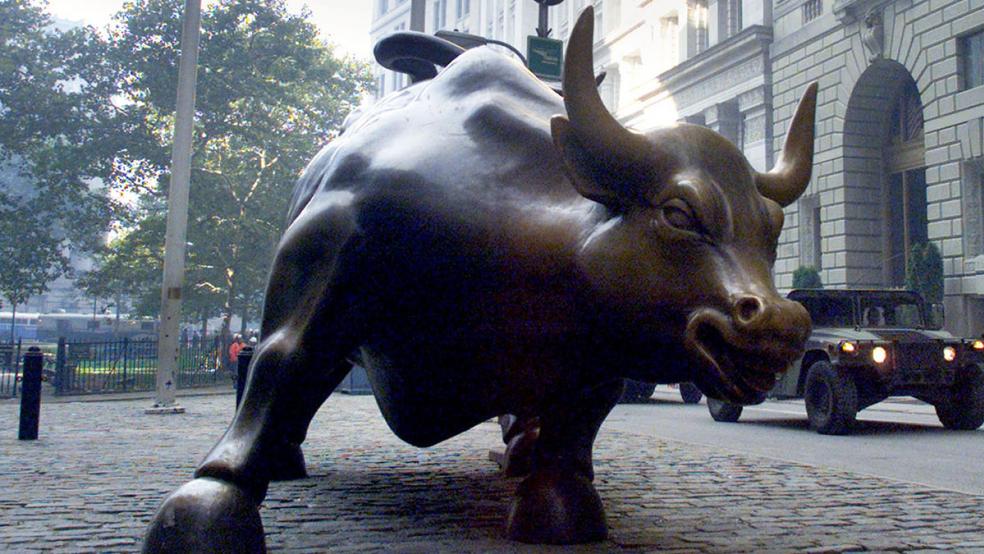U.S. equities really haven't gone anywhere for a while. The Dow Jones Industrial Average has spent the last few months trading just above 18,000 after spending the summer trading just below 18,000. And these are levels that were first reached in late 2014.
So we’ve seen a whole lot of sideways action, punctuated by periods of terror (like after the Brexit vote) and elation (during the July melt up). But the list of possible headwinds for stocks continues to grow as trading volumes pick up and we head deeper into October — seasonally one of the most harrowing months of the year and home to market crashes in 1929, 1987 and 2008.
Related: Wall St. Rallies on Strong Corporate Earnings Reports
Already, cracks are appearing in the façade of strength. Consider that the percentage of NYSE stocks above their 50-day moving average stands at just 32 percent as I write this — down from nearly 65 percent a few weeks ago, 75 percent back in August and nearly 85 percent back in July.
What's motivating the sellers? Any one of these seven bugaboos:
Bond Weakness/Yield Strength
The big news in recent weeks has been the weakness hitting long-term U.S. Treasury bonds, which in turn, is pushing up long-term interest rates. The 10-year yield, near 1.8 percent, is challenging levels not seen since early June, up from a low of 1.56 percent two weeks ago and 1.37 percent in early July.
That doesn't sound like much, but it's absolutely hammered so-called "safe haven" stocks — most of which are yield-sensitive income stocks — in areas like utilities, telecom and real estate investment trusts. This also echoes the market freak-out a few weeks ago surrounding the squeeze on "risk parity" trades.
Related: Citigroup Beats Profit Expectations on Bond Trading Comeback
The Utilities Select SPDR (XLU) dropped for 11 consecutive sessions through Oct. 7, and while it has recovered somewhat in the days since, is still down 6.5 percent from its late September high. That's nearly three years' worth of dividend income wiped away in just two weeks. Rising inflation expectations (driven by crude oil strength) are playing a role here.
The Dollar's Surge
Another safe haven, precious metals, has been slammed by a spurt of strength in the U.S. dollar. The PowerShares Dollar Bullish Fund (DB) jumped back over its 200-day moving average — a measure of medium-term strength — on Oct. 5 for the first time since July and has since screamed higher to levels not seen since March. Both gold and silver have been pushed back to levels last seen in June while gold stocks have fallen below their 200-day moving average for the first time since February.
The Federal Reserve
Rising odds of a Federal Reserve interest rate hike before the end of the year are the primary driver of the dollar's rise as well as the upward pressure on U.S. Treasury yields. This has been spurred on by some hawkish commentary from Fed officials. Specifically, Richmond Fed President Jeffrey Lacker, who has said there is a strong case for raising rates more rapidly. Relatively hawkish minutes from the Fed's last policy meeting in September are bolstering market-based odds of a December rate, which stand at 64 percent.
Related: As the Recovery Falls Short, the Fed Eyes a 'High Pressure' Economy
Q3 Earnings
It's easy to forget, but we're in the midst of a corporate earnings recession — one that is expected to end soon, but not before it stretches into its sixth quarter (driven by still-low energy prices, a strong dollar and tepid growth in Europe and Asia). Since stock prices haven't really budged in the last three years, despite a year-and-a-half off falling earnings, equity valuations now appear stretched.
Investors are going to be reminded of that fact as the third-quarter earnings season rolls on. According to FactSet, Q3 S&P 500 earnings are expected to decline 2.1 percent from last year. We get into the meat of the reporting season this week.
Q3 GDP Growth
If it wasn't enough that interest rates were rising, earnings were falling and the Fed was threatening to tighten policy, the U.S. economy remains moribund as well. Growth averaged just 1.25 percent in the first half of the year. And third-quarter growth is expected to clock in at just 1.9 percent, according to the Atlanta Fed's GDPNow real-time estimate — down from a high estimate of 3.8 percent back on Aug. 5. Economic data from construction spending to manufacturing activity have disappointed.
Political Risk
We are just a month away from the most contentious U.S. presidential election in at least a generation. While most polls show Hillary Clinton with an edge, Donald Trump and his aggressive economic nationalism still have a solid chance. A strong debate performance this week, or further revelations about Clinton’s emails or those of her campaign staff, could force the market to reevaluate Trump’s chances.
Related: What’s Ailing the Economy? Political Paralysis May Be the Biggest Problem
According to Macroeconomic Advisers, all else being equal, they believe stocks will rally 4 percent if Clinton wins but slump 7 percent if Trump wins.
The Rest of the World — Deutsche Bank, Bank of Japan, etc.
Finally, there is much to consider overseas.
The balance sheet health of German lender Deutsche Bank (DB) remains an open question. The bank is contending not only with legal costs associated with a possible settlement with the U.S. government over its residential mortgage-backed securities practices, but is dealing with bad Eurozone loans, higher funding costs and a weak European economy as well.
Separately, there have been reports that the European Central Bank could be considering a taper of its bond-buying program. The Bank of Japan is consciously trying to push up long-term interest rates to lower the costs of its negative interest rate stimulus. And the geopolitical situation is a mess, with tensions rising between the United States and Russia, the breakdown of the Syrian ceasefire, the renewed battle for Mosul and more.
Add it all up and investors have a lot to consider heading into the end of the year. It's a shame classic areas of safety like utilities and gold offer no haven at a time like this.






